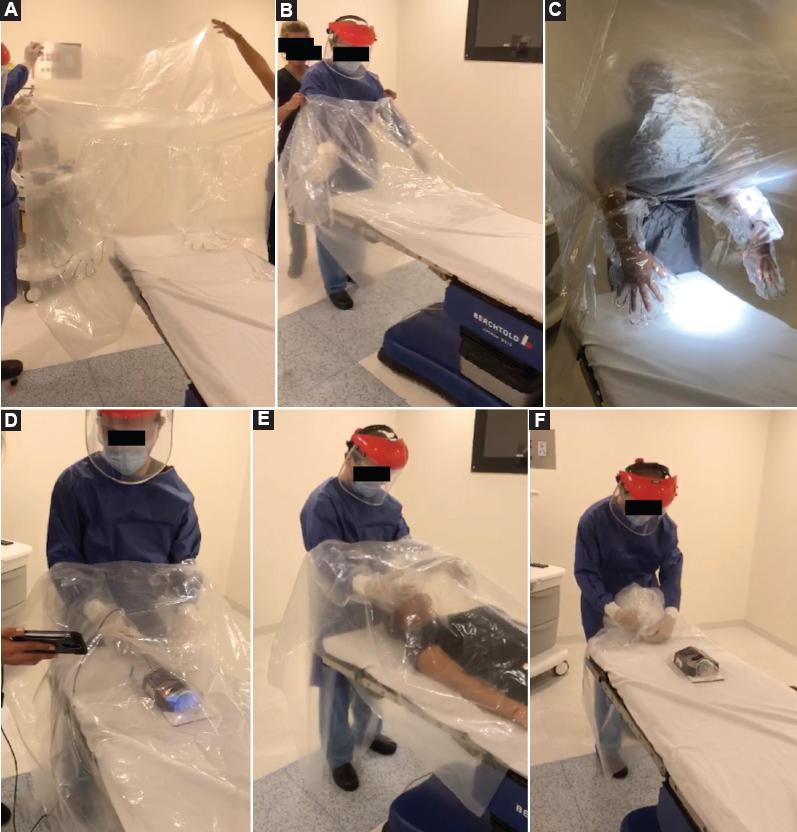“Dignity of human nature requires that we must face the storms of life”
— Mahatma Gandhi
To the Editor,
As the Coronavirus Disease (COVID)-19 pandemic continue to expand in our country, one of the most important issues to remark is the safety and effectiveness of equipment protection of all medical staff. This situation committed us to learn and innovate how to improve the management of COVID-19 patients but also how to protect ourselves. Many patients with COVID-19 will be in critical state and will need intubation for mechanical ventilation. Furthermore, many emergencies will continue to demand for urgent surgical care, and surgical patients might be infected with severe acute respiratory syndrome coronavirus-2 (SARS-CoV-2)1. The present device could be used in any scenario that required advanced airway management, like in the emergency department, the intensive care unit, endoscopy suites, and the operating room. This device could also be used in several aero-digestive tract procedures such as placement of nasogastric tubes or for taking pharyngeal swab specimens to test SARS-CoV-2.
We recommend the following steps for aerosol-generating medical procedures:
1. First, get familiarized with the device (Fig. 1).
2. Airway management needs to be performed with full PPE1.
3. Put the device on the table or stretcher where the patient will be inducted and intubated.
4. Unfold the device and identify the arm-holes and the special gloves that are integrated to the device.
5. Accommodate the patient onto the table or stretcher.
6. With the help of an assistant, insert the hands through the arm-holes, and inside the device’s gloves.
7. As previously suggested, plan for rapid sequence induction and avoid awake fiberoptic intubation when possible2,3.
8. Perform the intubation according with the appropriate technique. For a better visualization, we recommend to employ an electronic fiberscope connected to a high resolution screen or to a smart phone, away from the patient.
9. Ensure the airway and begin mechanical ventilation.
10. Remove and fold the device in an orderly fashion, avoid fast movements that could spread aerosolized particles.
11. Throw away the protective device into a special disposable bag.
12. When the procedure is finished, remove PPE avoiding self-contamination.

Figure 1 A: placing the device on the OR Table. B: dressing the physician with the device. C: full hand access through the device and within the integrated gloves. D: intubating with an electronic fiberscope. E: easy access to the airway. F: easily foldable, and completely disposable device.
While the pandemic continues, several different recommendations have been published on regards of the equipment necessary to protect during intubation. The use of an enhanced droplet/airborne PPE that incorporates the use of power air purifying respirator has been described2. Furthermore, it has been recommended that all aerosol-generating procedures should be done in an airborne infection isolation room3. Nevertheless, the increasing number of patients is overwhelming hospitals, and patients are being attended in improvised areas and not in appropriate negative-pressure rooms or individual airborne isolation rooms. Recently, several groups have described the employ of rigid acrylic boxes4. However, the disadvantages of these boxes are the rigidity that may limit the physician movements, the uncovered arm-holes may produce contact and exposure to the patients secretions, and the fact that is reusable4. These acrylic boxes need to be cleaned with soap and water or with disinfecting wipes, producing a potential source of infection to the person dedicated to clean them.
In comparison, this novel protective device is completely foldable and flexible, the arm-holes are covered with an integrated plastic gloves to avoid any contact with the patient, and the device could be used in any setting without the need of other accessories (surgical retractors). Other important issues of this novel device are the ease to manufacture it, the availability of materials to produce it, the very low cost (approximately 0.5 dollars or 15 pesos, or less), the ease of transportation, and the materials allow for sterilization to use it during surgical procedures.
In conclusion, this is a novel, very low-cost, completely disposable, and effective protective intubation device that could help any health care worker to perform safely all aerosol-generating aero-digestive tract medical procedures during the COVID-19 pandemic.











 nueva página del texto (beta)
nueva página del texto (beta)


